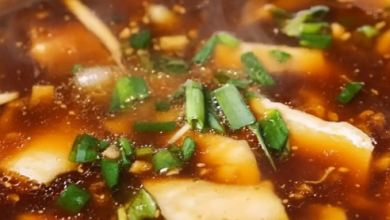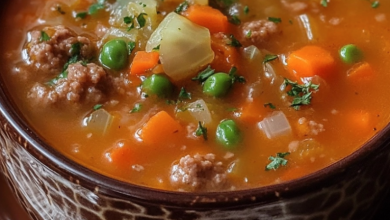Menestra de Verduras: A Deep Dive into Spain’s Celebrated Vegetable Stew
More Than Just a Stew
When one thinks of Spanish cuisine, images of sizzling paella, succulent jamón ibérico, and fiery patatas bravas often come to mind. Yet, nestled in the heart of this gastronomic powerhouse lies a humble, deeply comforting, and astonishingly flavorful dish that celebrates the very essence of the land: Menestra de Verduras (Spanish Vegetable Stew).
Far from a simple boiled vegetable medley, a true menestra is a symphony of seasonal spring produce, slowly simmered to tender perfection in a rich, savory broth. It’s a dish that speaks of family, tradition, and the Spanish reverence for fresh, high-quality ingredients. This article is your ultimate guide to understanding, appreciating, and mastering this classic of Spanish home cooking.
What is Menestra de Verduras? Defining a Classic
Menestra de Verduras is a traditional Spanish stew consisting of a variety of vegetables, typically those available in spring, cooked slowly and often enriched with ham, garlic, and sometimes a touch of tomato. The result is not a watery soup, but a cohesive, hearty dish where the vegetables are meltingly tender and infused with deep, umami-rich flavors.
The magic of a menestra lies in its two-stage cooking process: often, vegetables are first sautéed or blanched individually to preserve their unique textures and colors before being united in a final simmer. This meticulous approach elevates it from a simple pot of cooked vegetables to a refined and deliberate culinary creation.
A Brief History: From Humble Origins to Gourmet Tables
The origins of menestra are practical and rural. Like many great dishes, it was born from necessity a way for farmers and families to utilize the abundant, seasonal harvest of spring. The word “menestra” itself comes from the Italian “minestra,” meaning a light soup or stew, suggesting a possible historical influence across the Mediterranean.
Originally a humble peasant dish, menestra’s reputation grew as its incredible potential for flavor became undeniable. It evolved from a simple meal to a staple on family tables across Spain, especially during Lent and Easter (Cuaresma and Semana Santa), when many abstain from meat. Today, it’s celebrated in both homes and high-end restaurants, often featuring as a luxurious tapa or a main course, sometimes garnished with premium ingredients like wild asparagus or jamón serrano.
Regional Variations: A Tapestry of Taste Across Spain
While enjoyed nationwide, Menestra de Verduras finds its most famous expressions in specific regions:
- Navarra and La Rioja: These northern regions are arguably the epicenter of menestra. Here, it is often heartier, almost always includes fresh artichokes and white asparagus (for which Navarra is famous), and is frequently enriched with chunks of ham, chorizo, or even lamb.
- Andalusia: In the south, the stew might feature more tomatoes, peppers, and green beans, reflecting the different produce of the sun-drenched region.
- Castilla y León: The menestra here can be simpler, focusing on the pure flavors of the vegetables like carrots, leeks, and peas, with a focus on the quality of the sofrito base.
This regional diversity means there is no single “authentic” recipe, but rather a beautiful collection of interpretations united by a common philosophy.
The Essential Ingredients: A Celebration of Spring
The vegetable lineup can vary, but a classic menestra often includes:
- The Aromatics: Onion, garlic, and sometimes cured ham (jamón serrano or Ibérico) or pancetta for a deep, savory base (sofrito).
- The Heart of the Stew: Artichokes, green beans, peas, carrots, and potatoes.
- The Flavor Enhancers: Leeks, celery, and a touch of tomato (paste or fresh).
- The Liquids: A good-quality chicken or vegetable broth is essential for simmering.
- The Garnish: Hard-boiled eggs, serrano ham chips, and fresh parsley are common finishers.
How to Make Authentic Menestra de Verduras: A Step-by-Step Recipe
This recipe balances authenticity with practicality for the home cook.
Prep time: 30 minutes | Cook time: 45 minutes | Serves: 4-6
Ingredients:
- 1 large onion, finely chopped
- 4 cloves garlic, minced
- 100g jamón serrano or pancetta, diced (optional, omit for vegan)
- 2 tbsp olive oil
- 1 tbsp tomato paste
- 1 liter vegetable or chicken broth
- 2 medium carrots, peeled and sliced
- 2 medium potatoes, peeled and cubed
- 200g green beans, trimmed and cut
- 1 cup fresh or frozen peas
- 4-5 artichoke hearts (fresh, jarred, or frozen), quartered
- 1 bay leaf
- Salt and black pepper to taste
- Hard-boiled eggs and chopped parsley for garnish
Instructions:
- Prepare the Sofrito: In a large, heavy-bottomed pot or Dutch oven, heat the olive oil over medium heat. Add the diced jamón (if using) and cook for 2-3 minutes until it releases its fat. Add the chopped onion and cook for 8-10 minutes until soft and translucent. Add the minced garlic and cook for another minute until fragrant.
- Build the Base: Stir in the tomato paste and cook for a minute to mellow its acidity. This builds a flavorful foundation.
- Cook the Harder Vegetables: Add the carrots and potatoes to the pot. Stir to coat them in the sofrito. Pour in enough broth to just cover the vegetables. Add the bay leaf, bring to a boil, then reduce to a simmer. Cook for 10-15 minutes.
- Add the Medium Vegetables: Add the green beans and artichoke hearts. Simmer for another 10 minutes.
- Final Additions: Add the peas and any remaining broth. Season with salt and pepper (be careful with salt if using jamón). Simmer for a final 5-10 minutes, or until all vegetables are tender but not mushy. The broth should have reduced to a flavorful, light sauce.
- Serve: Remove the bay leaf. Ladle the stew into deep bowls. Garnish with a quartered hard-boiled egg and a generous sprinkle of fresh parsley. Serve with crusty bread to mop up the delicious broth.
Pro Tips for the Perfect Menestra:
- Blanch for Brilliance: For even brighter colors and perfect texture, blanch green beans and artichokes separately in boiling salted water for 2-3 minutes before adding them to the stew. Shock them in ice water to stop the cooking process.
- Sofrito is Key: Don’t rush the sofrito. Cooking the onions slowly until they are sweet is the number one secret to a deeply flavorful stew.
- Quality of Broth: Your menestra will only be as good as your broth. Use a high-quality homemade or store-bought broth.
- Let it Rest: Like many stews, menestra often tastes even better the next day after the flavors have had time to meld.
Conclusion: A Dish to Savor
Menestra de Verduras is more than a recipe; it’s a edible story of Spanish culture a testament to the power of simplicity, seasonality, and slow cooking. It’s a nourishing, healthy, and utterly delicious dish that brings the vibrant flavors of a Spanish spring to your table, no matter where you are in the world. So, gather your vegetables, take your time, and prepare to experience a true taste of Spain’s culinary soul.



